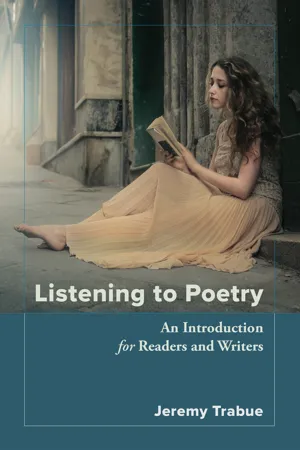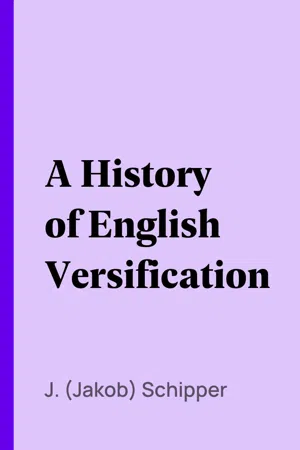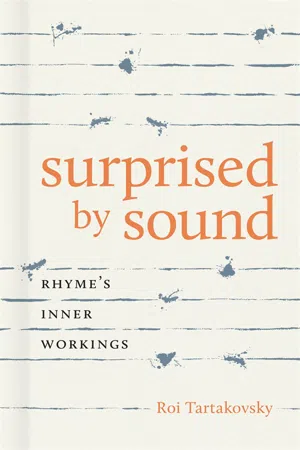Languages & Linguistics
Masculine Rhyme
Masculine rhyme is a type of rhyme that occurs when the final syllable of a word is stressed and rhymes with the final syllable of another word. This type of rhyme is often used in poetry and is considered to be more forceful and assertive than feminine rhyme, which occurs when the final syllable of a word is unstressed.
Written by Perlego with AI-assistance
Related key terms
5 Key excerpts on "Masculine Rhyme"
- eBook - ePub
Listening to Poetry
An Introduction for Readers and Writers
- Jeremy Trabue(Author)
- 2019(Publication Date)
- Chemeketa Press(Publisher)
Single rhymes are often called masculine, while multiple rhymes are often referred to as feminine. These terms don’t have anything to do with human genders. They derive from French poetry jargon and ultimately from the grammar of Latin, in which words are classified according to gender as a linguistic concept. Feminine rhyme is used in some comic verse forms, such as the limerick, and some people think of it as inherently comical. However, plenty of poems that don’t even crack a smile are written using feminine rhyme.Some people use the terms “feminine rhyme” and “Masculine Rhyme” more restrictively, not only distinguishing number of rhyming syllables but the relationship between the rhyming syllables and whether or not they are stressed.We don’t need to worry about those, or the many other, labels given to other types and sub-types of rhyme, but it’s worth considering how the interactions of stress and rhyme create variety and might impact how we hear and appreciate a poem. In the following rhyming word pairs, the stressed syllables are in bold, and the rhyming syllables are underlined :Singlebay / weigh —A stressed syllable is rhymed with aRhymesstressed syllable. la • dy / tab • by —An unstressed syllable is rhymed with an unstressed syllable.wing / ask • ing —A stressed syllable is rhymed with an unstressed syllable.Doubleab • bey / tab • by —The double rhyme starts with aRhymestressed and ends with an unstressed syllable. Tripleu • ni • fy • ing / tes • ti • fy • ing —the triple rhymeRhymestarts and ends with an unstressed syllable; the stressed syllable is between them. Most people find the rhymes in which a stressed syllable at the end of a word rhymes with a stressed syllable at the end of another word to be the “strongest”—clearest, most obvious. Rhymes like “lady / tabby,” on the other hand, may not feel like “real” rhymes at all to some. The final syllables have the exact same sound, but the initial syllables don’t. Those initial syllables are where the stress falls in each word, emphasizing the difference of those two syllables rather than the sameness of the final, rhyming syllables. This makes some people wonder if these are “real” rhyme. In short, the answer is yes. These differences may not seem important or even evident to you, but keep them in mind when analyzing the rhyme scheme of a poem. - eBook - ePub
The Princeton Encyclopedia of Poetry and Poetics
Fourth Edition
- Stephen Cushman, Clare Cavanagh, Jahan Ramazani, Paul Rouzer, Stephen Cushman, Clare Cavanagh, Jahan Ramazani, Paul Rouzer, Stephen Cushman, Clare Cavanagh, Jahan Ramazani, Paul Rouzer(Authors)
- 2012(Publication Date)
- Princeton University Press(Publisher)
One other way of approaching this issue, however, is to point out that rhyme depends less on the structure of the lang. than on the semantic field presently relevant in the poem: only some of the available rhymes for a given word are possible candidates for use in a poem on a given subject. What this means, most generally, is that it is dangerous to discuss rhyme as an abstract entity divorced from the constraints imposed on it in each individual poem. The subject of morphology and rhyme is a large and complex one that still remains to be mapped out.(3) By the position of the stress on the rhyming (and adjacent) syllables. Normally, single rhymes are ictic and stressed; double rhymes add an extra unstressed syllable. Rhyming masculine with feminine words, i.e., a stressed monosyllable with a disyllable the rhyming syllable of which is unstressed (e.g., sing / loving , free / crazy , afraid / decade ) Tatlock called “hermaphrodite” rhyme (an odd term, since male mating with female in love would not be thought so). Others have called it “apocopated” or “stressed-unstressed” rhyme; it was popular in the 16th and 17th cs. and is used by John Donne and by Ezra Pound (Hugh Selwyn Mauberley ). There is also “unstressed rhyme,” where the rhyming syllables are both unstressed or weak: e.g., honey / motley , mysteries / litanies , wretchedness / featureless . But there is some question whether this constitutes rhyme at all. Scherr calls all such cases in Rus. poetry “heteroaccentual” forms and cites the taxonomy given by Markov.A related type rhymes a stressed syllable with one bearing only secondary speech stress, which is promoted under metrical ictus, e.g., sees / mysteries . Many rhyme pairs of this sort formerly differed in pronunciation and were good rhymes in their time, though they are not now; others were not so, then as now. Rhymes like eye / harmony , eye / symmetry (William Blake), or flies / mysteries force the critic to call on the researches of historical phonology.Perhaps the most interesting case of all is the pair die / poetry , common in the Ren. There is some evidence (e.g., Alexander Gill in Logonomia Anglica , 1620) that, for words like poetry , alternative pronunciations existed as late as the first quarter of the 17th c., one form pronounced as the word is today, to rhyme with me , the other to rhyme with die . If so, rhyme pairs like poetry / die —and others like majesty / eye , crie / graciously , and most others ending in ty or ly —may well have been good rhymes for Shakespeare and the Ren. sonneteers, as they were for John Milton. But the diphthongal ending apparently lost out, so that sometime after 1650 poetry and die - eBook - ePub
- J. (Jakob) Schipper(Author)
- 2013(Publication Date)
- Perlego(Publisher)
number of the rhyming syllables.B. According to the quality of these syllables.C. According to the position of the rhyme in relation to the line and the stanza.Intimately connected with this last point is the use of rhyme as an element in the structure of the stanza. A. With regard to the number of the syllables, rhymes are divided into three classes, viz.:1. The monosyllabic or single rhyme (also called masculine), e.g. hand: land , face: grace .2. The disyllabic or double rhyme (also called feminine), as ever: never , brother: mother , treasure: measure , suppression: transgression ; or owe me: know me Shakesp. Ven. and Ad. 523–5; bereft me: left me ib. 439–41. The terms masculine and feminine originated with the Provençal poets and metrists, who were the first among the people of Western Europe to theorize on the structure of the verses which they employed, and introduced these terms in reference to the forms of the Provençal adjective, which were monosyllabic or accented on the last syllable in the masculine, and disyllabic or accented on the last syllable but one in the feminine: bos–bona , amatz–amada .3. The trisyllabic, triple, or tumbling rhyme, called gleitender (i.e. gliding) Reim in German. Of this variety of rhyme, which is less common than the two others, examples are gymnastical: ecclesiastical Byron, Beppo, 3; quality: liberality ib. 30; láugh of them: hálf of them ib. 98. Rhymes like this last, which are made up of more words than two, might, like those given above under the disyllables, such as owe me: know me , also form a separate sub-species as compound rhymes, as they resemble the broken rhymes (cf. § 217, B. 3) and have, like these, mostly a burlesque effect.§ 217. B. According to the second principle of classification, by the quality of the rhyming syllables, the species of rhyme are as follows:1. The rich rhyme (in French rime riche - eBook - ePub
Reclaiming the Christian Intellectual Tradition
A Student's Guide
- Louis Markos, David S. Dockery, David S. Dockery(Authors)
- 2012(Publication Date)
- Crossway(Publisher)
Don Juan , the light operas of Gilbert and Sullivan, and comedy-driven Broadway musicals all make heavy use of feminine rhymes.) By truncating his trochaic lines, the poet ensures that his lines will end on a stress—thus allowing him to use Masculine Rhymes. Consider the difference in feel and gravity between the following two pairs of lines (truncated trochaic tetrameter, followed by trochaic tetrameter):Nothing in my hand I bring, / Simply to the cross I cling Nothing in my hand I’m bringing / Simply to the cross I’m clingingThere is a firmness and nobility in the first pair of lines that is compromised in the second by the use of the less stately feminine rhyme, “bringing/clinging.”CATEGORIZING STANZAS
Thus far, I have considered individual lines of poetry in isolation. When we read actual poems, we encounter them not as individual lines but as members of a tightly knit group of lines known as a stanza . These stanzas are defined both by the meter of the lines that make them up and by the rhyme scheme that binds the lines together. Though it is possible to make use of a stanza that does not rhyme, in nearly all cases, the stanza will contain at least one pair of rhyming words. To designate the rhyme scheme of a stanza, we use the letters of the alphabet. If the four lines of a four-line stanza end with the words “may/sea/day/me,” then the rhyme scheme would be written thus: abab . If the last four words were “may/day/sea/me,” then the rhyme scheme would be aabb . If the last four words were “may/see/you/me,” then the rhyme scheme would be abcb . Although the majority of rhymes are exact rhymes (feel/steal), poets often use rhymes that are not exact (known as off rhymes or eye rhymes - eBook - ePub
Surprised by Sound
Rhyme's Inner Workings
- Roi Tartakovsky(Author)
- 2021(Publication Date)
- LSU Press(Publisher)
1 Hearing and Listening to Rhyme If negotiating with linguistic constraints and literary conventions comes with the territory of writing poetry, rhyme occupies a great part of that territory. Certainly, in the case of English, it is difficult to overstate the association between rhyme and poetry, or the significance of rhyme to poetry. This association is attested to in rhetoric by rhyme’s synecdochic or metonymic substitution for poetry itself. Rhyme-as-poem is a prevalent trope throughout much English-language poetry and is nowhere more evident than in William Shakespeare’s ending of Sonnet 17: “You should live twice, in it and in my rhyme.” In practice, rhyme’s prevalence is attested to by the overwhelming number of rhymed poems written by generations of poets. Of course, rhyme is not the only sound device, nor the earliest in the history of English poetry. A perfect or full rhyme is, in fact, one of numerous poetic sound devices, including assonance, alliteration, consonance, and many forms of partial rhymes. But it is the more encompassing member among most of these weaker or partial sound relations because full rhyme typically requires a correspondence of both the vowel and the following consonant sounds of the last stressed syllable of each word. 1 Assonance was never used systematically in English verse, partial rhyme is best appreciated as a subset of full rhyme, and alliteration, while carrying its own historical connotations of Anglo-Saxon prosody, seems, at least in poetic consciousness, more distant and dimmed today than rhyme. 2 Rhyme, both historically and phonetically, is set up to stand out in the soundscape of the poem or of poetry. As prevalent as rhyme is (or was —a question I will get to momentarily), it is easy to forget that rhyme’s entry into English poetry was a gradual process and one that—in spite of scholarly interest—remains somewhat murky. Murkier yet is the larger question of the historical origin of rhyme itself
Index pages curate the most relevant extracts from our library of academic textbooks. They’ve been created using an in-house natural language model (NLM), each adding context and meaning to key research topics.




